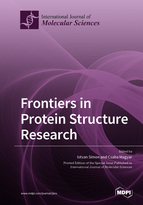Frontiers in Protein Structure Research
A special issue of International Journal of Molecular Sciences (ISSN 1422-0067). This special issue belongs to the section "Molecular Biophysics".
Deadline for manuscript submissions: closed (28 November 2021) | Viewed by 62751
Special Issue Editors
2. Center of Excellence of the Hungarian Academy of Sciences, 1117 Budapest, Hungary
Interests: protein structures; protein dynamics; protein conformation; protein folding; protein bioinformatics; protein interactions; membrane proteins; protein stability; intrinsically disordered proteins; protein biophysics; protein binding; molecular biophysics; protein refolding; membrane transport proteins; computational structural biology; structural bioinformatics
Special Issues, Collections and Topics in MDPI journals
Interests: protein bioinformatics; protein stability; intrinsically disordered proteins; protein structure; protein structure modeling; protein dynamics; molecular dynamics simulation; protein conformation; computational structural biology; structural bioinformatics; drug design; structure based drug design
Special Issues, Collections and Topics in MDPI journals
Special Issue Information
Dear Colleagues,
In recent years, new frontiers opened in protein structure research. Besides the traditional form of proteins, like folded water soluble proteins, transmembrane and membrane associated proteins, disordered proteins which able to fold on the surface of folded proteins or other stable macromolecules, new forms of proteins and protein complexes emerged. Among others, fuzzy complexes in which during physiological function at least one protein component is still in disordered form, mutual synergistic folding complexes in which two or more disordered proteins help each-other to fold, are new subclasses of proteins. Combination of the above mentioned proteins, like partially disordered proteins or proteins participating in liquid-liquid phase separation, represent new forms of proteins. These are all new and interesting fields of proteins structure research.
As guest editors of the “Frontiers in protein structure” special issue of IJMS, we would like to invite you to contribute a paper related to protein structures.
Prof. Dr. Istvan Simon
Dr. Csaba Magyar
Guest Editors
Manuscript Submission Information
Manuscripts should be submitted online at www.mdpi.com by registering and logging in to this website. Once you are registered, click here to go to the submission form. Manuscripts can be submitted until the deadline. All submissions that pass pre-check are peer-reviewed. Accepted papers will be published continuously in the journal (as soon as accepted) and will be listed together on the special issue website. Research articles, review articles as well as short communications are invited. For planned papers, a title and short abstract (about 100 words) can be sent to the Editorial Office for announcement on this website.
Submitted manuscripts should not have been published previously, nor be under consideration for publication elsewhere (except conference proceedings papers). All manuscripts are thoroughly refereed through a single-blind peer-review process. A guide for authors and other relevant information for submission of manuscripts is available on the Instructions for Authors page. International Journal of Molecular Sciences is an international peer-reviewed open access semimonthly journal published by MDPI.
Please visit the Instructions for Authors page before submitting a manuscript. There is an Article Processing Charge (APC) for publication in this open access journal. For details about the APC please see here. Submitted papers should be well formatted and use good English. Authors may use MDPI's English editing service prior to publication or during author revisions.
Keywords
- fuzzy complexes
- intrinsically disordered proteins
- liquid-liquid phase separation
- mutual synergistic folding
- protein dynamics
- protein folding
- protein structure
- protein-protein interactions
- transmembrane proteins








